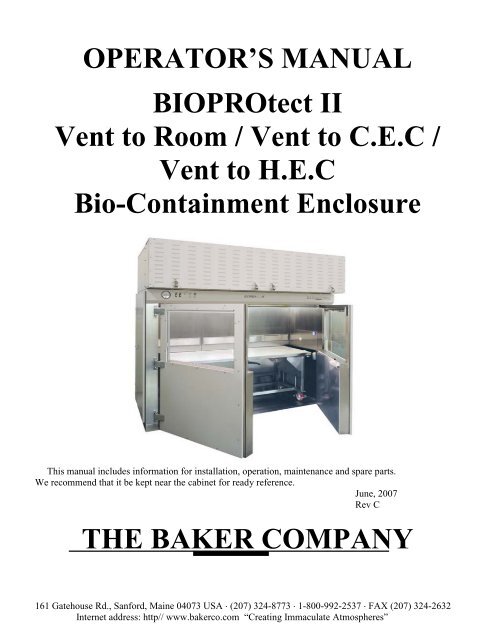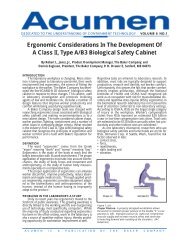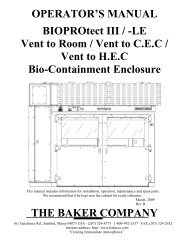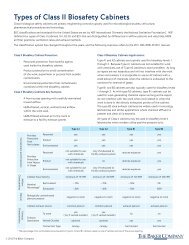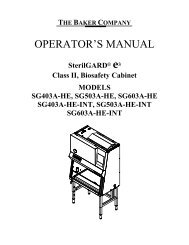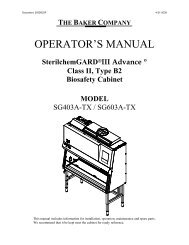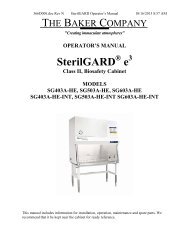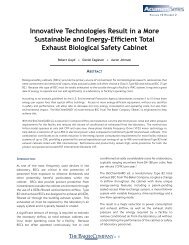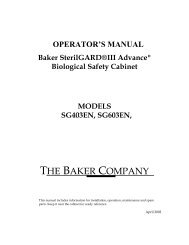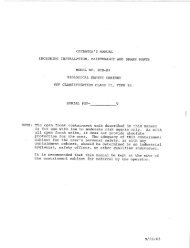OPERATOR'S MANUAL BIOPROtect II Vent to ... - Baker Company
OPERATOR'S MANUAL BIOPROtect II Vent to ... - Baker Company
OPERATOR'S MANUAL BIOPROtect II Vent to ... - Baker Company
Create successful ePaper yourself
Turn your PDF publications into a flip-book with our unique Google optimized e-Paper software.
OPERATOR’S <strong>MANUAL</strong><strong>BIOPROtect</strong> <strong>II</strong><strong>Vent</strong> <strong>to</strong> Room / <strong>Vent</strong> <strong>to</strong> C.E.C /<strong>Vent</strong> <strong>to</strong> H.E.CBio-Containment EnclosureThis manual includes information for installation, operation, maintenance and spare parts.We recommend that it be kept near the cabinet for ready reference.June, 2007Rev CTHE BAKER COMPANY161 Gatehouse Rd., Sanford, Maine 04073 USA ⋅ (207) 324-8773 ⋅ 1-800-992-2537 ⋅ FAX (207) 324-2632Internet address: http// www.bakerco.com “Creating Immaculate Atmospheres”
The <strong>Baker</strong> <strong>Company</strong>INTRODUCTION AND WELCOMEIt is a pleasure <strong>to</strong> welcome you <strong>to</strong> the growing number of cus<strong>to</strong>mers who own and operate <strong>Baker</strong>biological safety cabinets. As the inven<strong>to</strong>rs of the laminar flow biological safety cabinet and the leaders inthe field, <strong>Baker</strong> people take special pride in providing a cabinet that is designed for maximum performance.Your new <strong>BIOPROtect</strong> <strong>II</strong> cabinet includes many unique features which are included <strong>to</strong> give you superiorperformance, simpler maintenance and lower life cycle cost. Your <strong>BIOPROtect</strong> <strong>II</strong> cabinet is designed forboth safety and value.In addition <strong>to</strong> the high quality you expect from all <strong>Baker</strong> equipment, this model has been ergonomicallydesigned <strong>to</strong> provide the lab user with many exciting design features. The revolutionary ergonomic designwill help prevent repetitive motion injury, reduce fatigue and lab accidents and enhance productivity.You will find your <strong>BIOPROtect</strong> <strong>II</strong> cabinet suitable for use not only for research and clinical diagnostic workinvolving tissue culturing of possibly infectious samples, but also for I.V. drug preparations and otherpharmaceuticals that could have adverse health effects on opera<strong>to</strong>rs and other techniques requiring acontamination-free atmosphere.Please note that all open-front containment cabinets, including this one, are for use with low <strong>to</strong> moderaterisk agents only. Open-front cabinets do not provide absolute protection for the user. The adequacy of acabinet for user safety should be determined on-site by an industrial hygienist, safety officer or otherqualified person. Remember that you, the owner and user, are ultimately responsible and that you use yourcabinet at your own risk.We recommend that this manual, along with fac<strong>to</strong>ry test report, be kept near the cabinet for convenientreference by opera<strong>to</strong>rs and qualified maintenance personnel. If you have any questions about the use orcare of your new <strong>BIOPROtect</strong> <strong>II</strong> cabinet, please do not hesitate <strong>to</strong> contact our Cus<strong>to</strong>mer ServiceDepartment at 800-992-2537 for assistance or e-mail us at bakerco@bakerco.com.Sincerely,Dennis EaglesonPresident, CEOThe <strong>Baker</strong> <strong>Company</strong>, Inc.P.O. Drawer E, Sanford, Maine 04073 (207) 324-8773 1-800-992-2537 FAX (207) 324-3869Visit our website at www.bakerco.com
Table of ContentsINTRODUCTION AND WELCOME ................................................................................................ iTable of Contents ............................................................................................................................... iiI - FUNCTION AND DESCRIPTION OF THE <strong>BIOPROtect</strong> <strong>II</strong> CABINET .................................... 1Airflow Inside the <strong>BIOPROtect</strong> <strong>II</strong> Cabinet .................................................................................... 1Access <strong>to</strong> the Work Area................................................................................................................ 2Design Details ................................................................................................................................ 3Performance assurance.............................................................................................................. 3All-metal plenums..................................................................................................................... 3Tested HEPA filters .................................................................................................................. 3Work area lighting .................................................................................................................... 3Cable Port.................................................................................................................................. 3Optional Height Adjustable Cart.................................................................................................... 3Specifications ................................................................................................................................. 4Dimensions: .............................................................................................................................. 4Weights ..................................................................................................................................... 4Utilities:.......................................................................................................................................... 4Mechanical................................................................................................................................ 4Electrical ................................................................................................................................... 4Environmental Conditions.............................................................................................................. 5Symbols and Terminology ............................................................................................................. 5<strong>II</strong> - PREPARING THE <strong>BIOPROtect</strong> <strong>II</strong> CABINET FOR USE .......................................................... 6The Uses of the <strong>BIOPROtect</strong> <strong>II</strong>...................................................................................................... 6Location Within the Labora<strong>to</strong>ry..................................................................................................... 6Opera<strong>to</strong>r Controls:.......................................................................................................................... 7Blower On / Off Switch – ......................................................................................................... 7Light On / Off Switch – ............................................................................................................ 7Mute switch - ............................................................................................................................ 7Left Side & Right Side Outlet On / Off – ................................................................................. 8Ground Fault Circuit Interrupter .................................................................................................... 8Air Pressure Alarm......................................................................................................................... 8Door Operations ............................................................................................................................. 9To open the viewscreen: ........................................................................................................... 9To open the door:...................................................................................................................... 9
Removing the cart .......................................................................................................................... 9Start-up procedure ........................................................................................................................ 11Reacting <strong>to</strong> Spills.......................................................................................................................... 12Decontamination .......................................................................................................................... 13About the HEPA Filters ............................................................................................................... 15IV - ON-SITE CHECKS AND MAINTENANCE PROCEDURES ............................................... 16Filter Media and Seal Leak Tests ................................................................................................. 16Procedure for filter leak tests........................................................................................................ 17The Airflow Balance .................................................................................................................... 18Airflow Smoke Pattern Test ......................................................................................................... 19Grounding Continuity Test........................................................................................................... 19Calibration procedure for Modus Airflow alarm(Digital Differential Pressure Moni<strong>to</strong>r). .......... 20Initial Set Point Settings.......................................................................................................... 20Low Flow Alarm Setting ........................................................................................................ 20Check the Calibration ............................................................................................................. 20Modus Programming Instructions ................................................................................................ 211.) Programming the Alarm Set points ................................................................................... 212.) Programming the Relay Dead band................................................................................... 213.) Returning <strong>to</strong> Normal Operation......................................................................................... 21Maintenance Notes ....................................................................................................................... 22Replacing the HEPA Filter........................................................................................................... 22Changing the Exhaust Filter.................................................................................................... 22Changing the Supply Filter ..................................................................................................... 23V. - TROUBLE SHOOTING .......................................................................................................... 24REPLACEMENT PARTS LIST .................................................................................................. 26VI. APPENDIX ................................................................................................................................ 27Modus Installation and Operation Handbook............................................................................... 28BGA-<strong>BIOPROtect</strong> <strong>II</strong> <strong>Vent</strong> <strong>to</strong> Room Page 1................................................................................. 42BGA-<strong>BIOPROtect</strong> <strong>II</strong> <strong>Vent</strong> <strong>to</strong> Room Page 2................................................................................. 43BGA-<strong>BIOPROtect</strong> <strong>II</strong> <strong>Vent</strong> <strong>to</strong> Room Page 3................................................................................ 44BGA-<strong>BIOPROtect</strong> <strong>II</strong>-19 Hard Exhaust Connection(HEC) Page 1 .............................................. 45BGA-<strong>BIOPROtect</strong> <strong>II</strong>-19 Hard Exhaust Connection(HEC) Page 2 .............................................. 46BGA-<strong>BIOPROtect</strong> <strong>II</strong>-19 Hard Exhaust Connection(HEC) Page 3 .............................................. 47
BGA-<strong>BIOPROtect</strong> <strong>II</strong>-20 Canopy Exhaust Connection (CEC) Page 1......................................... 48BGA-<strong>BIOPROtect</strong> <strong>II</strong>-20 Canopy Exhaust Connection (CEC) Page 2......................................... 49BGA-<strong>BIOPROtect</strong> <strong>II</strong>-20 Canopy Exhaust Connection (CEC) Page 3......................................... 50BGA-<strong>BIOPROtect</strong> <strong>II</strong> Optional Cart ............................................................................................. 51Wiring Diagram-Standard <strong>BIOPROtect</strong> <strong>II</strong> ................................................................................... 52Wiring Diagram – Master <strong>BIOPROtect</strong> <strong>II</strong> ................................................................................... 53WARRANTY................................................................................................................................... 54Test Report…………………………………………………………………………….Attached
I - FUNCTION AND DESCRIPTION OF THE <strong>BIOPROtect</strong> <strong>II</strong> CABINETThe <strong>BIOPROtect</strong> <strong>II</strong> is a Class <strong>II</strong> Bio-Containment Enclosure designed <strong>to</strong> house labora<strong>to</strong>ry robotics orlarge apparatus that would not ordinarily fit in a standard Class <strong>II</strong> Biological Safety Cabinet (BSC). Someimportant features of the <strong>BIOPROtect</strong> <strong>II</strong> include, vertical laminar airflow, a front access opening, as well assupply & exhaust HEPA filters. The unit is designed <strong>to</strong> protect not only the environment and the peopleusing the cabinet, but also the product within from airborne contaminants. The <strong>BIOPROtect</strong> <strong>II</strong> can beconfigured <strong>to</strong> vent three different ways. <strong>Vent</strong> <strong>to</strong> the room, <strong>Vent</strong> <strong>to</strong> a Canopy Exhaust Connection (C.E.C.)via a house exhaust system or, <strong>Vent</strong> <strong>to</strong> a Hard Exhaust Connection (H.E.C.) via a house exhaust system.Although your unit has passed a microbiological test, a modification of NSF/ANSI standard-49-2002e, the<strong>BIOPROtect</strong> <strong>II</strong> is not currently listed with the NSF.Airflow Inside the <strong>BIOPROtect</strong> <strong>II</strong> CabinetFigure 1 shows the name and location of component parts and the typical airflow pattern of the<strong>BIOPROtect</strong> <strong>II</strong>.The stainless steel metal diffuser (1) just below the supply HEPA (High Efficiency Particulate Air) filterassures that the work area is bathed in HEPA filtered air. The supply air stream splits so that some isdirected in<strong>to</strong> the front grille (2) and the balance is pulled in<strong>to</strong> the perforated grilles on the rear wall (3). On aflat table <strong>to</strong>p, in the absence of any obstacles, the air should split roughly in the center of the table.Because the cabinet must take in air <strong>to</strong> replace the air which is expelled through the exhaust filter, thesame quantity of room air enters the cabinet through the eight inch front access opening. The flow of theintake air provides the personnel protection (containment) aspect of the cabinet.The front grille of the cabinet is integral <strong>to</strong> the large hinged doors. These doors, as well as the side andrear walls, are maintained under a negative pressure. Air is drawn from the front intake grilles, in<strong>to</strong> thehollow doors, and in<strong>to</strong> the side walls. In this manner the outside air that is drawn in<strong>to</strong> the cabinet as intake isnot allowed <strong>to</strong> penetrate the table <strong>to</strong>p area of the cabinet.Any and all contaminated air that is captured in the cabinet’s negative pressure plenums (front doors,sidewalls, rear walls or upper plenum) is pulled in<strong>to</strong> the cabinet’s blower (4). The blower discharges in<strong>to</strong> a steelbox that is a common plenum for the supply and exhaust HEPA filters (5). In this manner, all the air that ishandled by the cabinet is HEPA filtered. The <strong>BIOPROtect</strong> <strong>II</strong> will exhaust a quantity of air (6) equal <strong>to</strong> thatreceived at the front intake grilles. If a leak should occur in a contaminated pressure plenum the negativepressure will create suction and pull air in, not allowing it <strong>to</strong> escape in<strong>to</strong> the labora<strong>to</strong>ry. If there is a leakfrom the positive pressure plenum, the surrounding negative pressure area will recapture the contaminated airand recirculate it through a HEPA filter.Page 1 of 54
Figure 1 Typical section with airflow visualization arrowsAccess <strong>to</strong> the Work AreaThe <strong>BIOPROtect</strong> <strong>II</strong> is provided with three modes of access <strong>to</strong> the work area; via the large hinged doorsthat can be opened <strong>to</strong> access the entire work area, the hinged viewscreens (providing access <strong>to</strong> the worksurface) or from the 8” x 42” access (sash) openings between the bot<strong>to</strong>m of the closed viewscreens and theair intake grates. The primary means of access must be through the 8” sash openings. This is the only meansof access that will ensure the user protection from contaminants within the enclosure.The opera<strong>to</strong>r is only protected from airborne particulate when the large front doors and the hinged viewscreensare closed and secured <strong>to</strong> provide the 8”x 42” access (sash) openingsFor easy set-up of equipment in the work area, the <strong>BIOPROtect</strong> <strong>II</strong> has two large doors that exposes theentire work area from floor <strong>to</strong> ceiling <strong>to</strong> an area of 102” wide x 68” tall.Page 2 of 54
Design DetailsPerformance assuranceMeticulous care in manufacturing is followed by more than 14 separate performance tests prior <strong>to</strong>shipment of your cabinet. In addition, a complete fac<strong>to</strong>ry test report on the operation of your unit isincluded at the rear of this manual.All-metal plenumsThe work area surfaces and plenums of your <strong>BIOPROtect</strong> <strong>II</strong> have been constructed entirely of metalin order <strong>to</strong> provide strength, durability, air-tightness and resistance <strong>to</strong> deterioration. Externalconstruction is of 16-gauge cold-rolled steel, protected by a smooth white baked enamel finish.Tested HEPA filtersSupply and exhaust HEPA filters in the <strong>BIOPROtect</strong> <strong>II</strong> unit have been found <strong>to</strong> be 99.99 percenteffective on particles of 0.3 micron size. Each filter is scan-tested <strong>to</strong> assure leak-free installation.Work area lightingThe fluorescent lights are externally mounted within the light canopy <strong>to</strong> minimize heat buildup in thework area. The unit uses four common F32T8 fluorescent bulbs powered by an efficient and reliableelectronic ballast.Cable PortA 2.75” I.D. cable port is provided in each side wall <strong>to</strong> accommodate communications ports fromprocess equipment without compromising performance.Optional Height Adjustable CartThe all stainless steel cart, which is optional on the <strong>BIOPROtect</strong> <strong>II</strong> was designed <strong>to</strong> accommodateprocess equipment weighing no more than 500 Lbs. It’s work surface dimensions are 90” Wide x 34” Deep.The height of the worksurface can be adjusted by the opera<strong>to</strong>r from 27” <strong>to</strong> 39” by using the manual crankprovided at the front of the cart. For ideal ergonomic performance the cart should be adjusted so that thework table of the equipment is at the same level as the front intake grille of door on the front of the cabinet.The cart is provided with swivel casters, all of which are locking. To retract the cart from the work area,tip the foot operated locking devices at each front caster <strong>to</strong> a horizontal position then pull the cart out of thework area. To return the cart <strong>to</strong> the cabinet push the cart back in<strong>to</strong> the work area and lock the front castersby pushing down on the foot operated locking devices. Make certain that the crank handle for the lift systemis facing the front of the cabinet and is retracted under the work table before closing the door.Page 3 of 54
SpecificationsDimensions:Outside: 116.88”W x 50.00”D x 107”H (over junction boxes)Usable work area: 102”W x 36.5”D x 75”H (under diffuser)Cart worksurface: 90”W x 34” D x (27”- 39”) H (height adjusted by opera<strong>to</strong>r).WeightsUnit weight: The weight of the <strong>BIOPROtect</strong> <strong>II</strong> cabinet is approximately 2315 lbs.Cart weight: The weight of the <strong>BIOPROtect</strong> <strong>II</strong> cart is approximately 500 lbs.Maximum worksurface capacity: 500 Lbs. uniform load.Point loads not <strong>to</strong> exceed 125 Lbs. eachUtilities:MechanicalFour (4) 3/8” NPT female connections provided for plumbing; all are pre-plumbed <strong>to</strong> the <strong>to</strong>p of theunit using 3/8” copper tubing. No service fixtures or valves are provided. User must supply fixtures <strong>to</strong>mate with 3/8” NPT female connection on side walls (see general arrangement drawing for details).ElectricalCaution: This cabinet is powered from more that one power source. The cabinet is not electrically safe unlessall power sources are disconnected. Use proper Lock Out / Tag Out procedures.All electrical wiring should comply with the National Electrical Code and any applicable Local Electrical Codesat the site of installation.The standard <strong>BIOPROtect</strong> <strong>II</strong> has three junction boxes located on the front of the <strong>to</strong>p deck. Thefollowing services need <strong>to</strong> be connected <strong>to</strong> the junction boxes.One 220Volt, 20Amp, 60 Hz, Single phase connection <strong>to</strong> power the two blowers. This circuit should bewired using 12 AWG wire and provided with a 20 Amp circuit breaker that will serve as a disconnectfor this power supply.One 120 V, 15Amp, 60 Hz, Single phase connection for control power and power <strong>to</strong> the left side wallduplex outlet. This circuit should be wired using 14 AWG wire and provided with a 15 Amp circuitbreaker that will serve as a disconnect for this power supply.One 120 V, 15Amp, 60 Hz, Single phase connection for power <strong>to</strong> the right side wall duplex outlet. Thiscircuit should be wired using 14 AWG wire and provided with a 15 Amp circuit breaker that willserve as a disconnect for this power supply.The circuit breakers for these services are <strong>to</strong> be located in close proximity <strong>to</strong> the cabinet.Otherconnections may be required for optional equipment.The <strong>BIOPROtect</strong> <strong>II</strong> incorporates solid-state ‘Stedivolt’ controllers <strong>to</strong> adjust the blower mo<strong>to</strong>r speed. Thisunit compensates for some variation in incoming line voltage. The usable voltage range is 105 <strong>to</strong> 240VPage 4 of 54
AC. You will need <strong>to</strong> consult the most recent certification test report on the unit <strong>to</strong> determine what thevoltage setting should be for your unit.Environmental ConditionsThe <strong>BIOPROtect</strong> <strong>II</strong> is designed <strong>to</strong> be used under the following conditions:Indoor useAltitudes up <strong>to</strong> 2000 metersTemperature range from 5° C <strong>to</strong> 40° CRelative humidity up <strong>to</strong> 80%Main supply voltage105 <strong>to</strong> 130 V AC for 120V circuits200 <strong>to</strong> 240V AC for 220V circuitsMaximum relative humidity 80 percent for temperatures up <strong>to</strong> 31°C decreasing linearly <strong>to</strong> 50 percentrelative humidity at 40°C.Transient over voltages according <strong>to</strong> Installation Category (OVERVOLTAGE CATEGORIES) <strong>II</strong> per UL61010-1, Annex J.Pollution Degree 2Symbols and TerminologyProtective Earth: Any terminal which is intended for connection <strong>to</strong> an external protectiveconduc<strong>to</strong>r for protection against electric shock in case of a fault.!General Caution: Refer <strong>to</strong> the instruction manual for information regarding personnel andenvironment protection.Page 5 of 54
The Uses of the <strong>BIOPROtect</strong> <strong>II</strong>.<strong>II</strong> - PREPARING THE <strong>BIOPROtect</strong> <strong>II</strong> CABINET FOR USEThe <strong>BIOPROtect</strong> <strong>II</strong> cabinet has been designed <strong>to</strong> provide a work area that protects the experiment fromthe environment (Product protection), and protects the users from the experiment (personnel protection or‘containment’). The laminar flow biological safety cabinet is designed for work with Biosafety Levels 1, 2and 3 (low <strong>to</strong> moderate risk) agents as listed in The Center for Disease Control’s “Biosafety inMicrobiological and Biomedical Labora<strong>to</strong>ries”, U.S. Department of Health and Human Services, PublicHealth Service, Centers for Disease Control and National Institutes of Health, U.S. Government PrintingOffice, Washing<strong>to</strong>n, D.C. 20402. HHS publication number (CDC) 84-8395.Extremely high risk agents assigned <strong>to</strong> Biosafety level 4 should never be used in this cabinet except in acertified BSL4 suit room. Please consult your safety professional for a proper risk assessment.Cautions* The use of any hazardous material in the cabinet requires that it be moni<strong>to</strong>red by an industrial hygienist, safetyofficer or other qualified individual.* Explosive or flammable substances should never be used in the cabinet unless a qualified safety professionalhas evaluated the risk.* If hazardous biological work is <strong>to</strong> be performed, apply the appropriate biohazard decal which is enclosed. Thisis in accord with OSHA regulations, volume 39, number 125, Part <strong>II</strong>.* If chemical, radiological or other non-microbiological hazards are present, be sure <strong>to</strong> employ appropriateprotective measures in addition <strong>to</strong> formaldehyde decontamination. Call upon a suitably trained individual <strong>to</strong>moni<strong>to</strong>r the operation.Also refer <strong>to</strong> section 2 of this manual the section entitled “Decontamination”Location Within the Labora<strong>to</strong>ryPROPER PLACEMENT WITHIN THE LABORATORY IS ESSENTIAL.The ideal location for any laminar flow biological safety cabinet is in a dead-end corner of the labora<strong>to</strong>ryaway from personnel traffic, vents, doors, windows or any other sources of disruptive air currents. Publishedresearch from The <strong>Baker</strong> <strong>Company</strong> (see Rake ASM paper, reference #34 in Appendix) and unpublished testsperformed at the National Cancer Institute show that if a draft or other disruptive air current were <strong>to</strong> exceedthe intake velocity of the cabinet, then contamination can enter the work area or escape from it.Page 6 of 54
<strong>II</strong>I - PROPER CABINET USECaution:If the proper use of the cabinet is not unders<strong>to</strong>od or the cabinet is not operated correctly itwill not provide an adequate personnel or product protection.The <strong>BIOPROtect</strong> <strong>II</strong> is designed for continuous operation. The <strong>Baker</strong> <strong>Company</strong> recommends continuousoperation <strong>to</strong> keep the interior work space clean and free of unwanted particles. If the blower is not running,the workspace of the cabinet will become contaminated with room air. It would be helpful for opera<strong>to</strong>rs <strong>to</strong>learn about the capabilities and limitations of the cabinet by reading some of the available literature. TheEagleson Institute offers several videotapes and an interactive CD which illustrate proper operationtechniques for biological safety cabinets.A biological safety cabinet is a valuable supplement <strong>to</strong> good sterile technique, but is not a replacement forit. All activities that are <strong>to</strong> be performed in your cabinet should first be approved by a competentprofessional, such as an industrial hygienist or safety officer. This will ensure the cabinet is appropriate forthe work it will be required <strong>to</strong> do. A competent professional should moni<strong>to</strong>r the cabinet and its operatingpersonnel at regular intervals <strong>to</strong> see that it is being used correctly.Opera<strong>to</strong>r Controls:The opera<strong>to</strong>r controls and indica<strong>to</strong>rs are arranged on the front panel of the unit.Blower On / Off Switch –This push but<strong>to</strong>n is a maintained action switch that controls the power <strong>to</strong> the cabinet blowers.Pressing and releasing the push but<strong>to</strong>n from the UP/OFF position will change the switch <strong>to</strong> theDOWN/ON position. The cabinet blowers will start. The GREEN indica<strong>to</strong>r in the push but<strong>to</strong>n willilluminate. Pressing and releasing the push but<strong>to</strong>n from the DOWN/ON position will change the switch<strong>to</strong> the UP/OFF position.Caution:The cabinet audible alarm is disabled when the Blower switch is in the OFF positionLight On / Off Switch –This push but<strong>to</strong>n is a maintained action switch that controls the power <strong>to</strong> the cabinet fluorescentlights. Pressing and releasing the pushbut<strong>to</strong>n from the UP/OFF position will change the switch <strong>to</strong> theDOWN/ON position. The cabinet lights will illuminate. The GREEN indica<strong>to</strong>r in the pushbut<strong>to</strong>n willilluminate. Pressing and releasing the pushbut<strong>to</strong>n from the DOWN/ON position will change the switch <strong>to</strong>the UP/OFF position.Mute switch -This push but<strong>to</strong>n is a momentary action switch that temporarily mutes the audible alarm. A timermodule inside the canopy controls the length of time that the alarm is muted. This is set at 5 minutes as afac<strong>to</strong>ry default but can be changed <strong>to</strong> 1 second <strong>to</strong> 100 hours. It may be desirable <strong>to</strong> increase this settingwhen cabinet decontamination is being performed. The YELLOW indica<strong>to</strong>r in the push but<strong>to</strong>n willilluminate while the alarm mute function is active. Should the alarm condition be remedied before themute ‘times-out’ the timer will be reset and the mute indica<strong>to</strong>r will not be illuminated.Page 7 of 54
Left Side & Right Side Outlet On / Off –A separate 10 amp circuit breaker/switch is supplied for the remote switching of power <strong>to</strong> the rightand left outlet receptacle located inside the <strong>BIOPROtect</strong> <strong>II</strong> .The breaker switches will ‘trip’ if the <strong>to</strong>talelectrical load on the circuit exceeds 10 amps.Ground Fault Circuit InterrupterGround fault circuit interrupter (GFCI) outlets are installed on the 120V power circuit on this cabinet.The GFCI is designed <strong>to</strong> protect the opera<strong>to</strong>r from a possible electrical ground fault hazard. If ahazardous condition exists the GFCI will cut off electricity <strong>to</strong> the outlet. The but<strong>to</strong>n in the center of theunit will pop out. If the GFCI “trips” you should first determine and correct the cause of the problem,then press the but<strong>to</strong>n <strong>to</strong> reset the GFCI.Air Pressure AlarmThe Air pressure alarm is controlled by a Modus Air Pressure indica<strong>to</strong>r mounted in the controlcanopy. Operating & set up instructions for this instrument can be found in the On-Site Checks AndMaintenance section of this manual. When either a High or Low flow condition is present for more than3 seconds the audible alarm will be activated. Pressing the Mute switch will silence the alarm. The mutetime is determined by the setting of a timer inside the control canopy. Fac<strong>to</strong>ry setting of this timer is 5minutes. Consult the test report for your cabinet for the fac<strong>to</strong>ry set flow conditions for this alarm. The<strong>Baker</strong> <strong>Company</strong> recommends continuous operation <strong>to</strong> keep the interior work space clean and free ofunwanted particles.Caution: The cabinet audible alarm is disabled when the Blower switch is in the OFF positionThis feature allows the user <strong>to</strong> turn-off the cabinet blowers when no longer required and the processeswithin the cabinet are found <strong>to</strong> be safe <strong>to</strong> personnel and the environment.Caution: It is recommended that prior <strong>to</strong> turning the Blower OFF you contact your health and safety officer fordecontamination procedures.Also refer <strong>to</strong> section 2 “Decontamination”Page 8 of 54
Door OperationsDuring cabinet operation, the only access that should be permitted is through the 8” sash openingsprovided at the front of the cabinet. For set-up purposes, the viewscreen or the large front doors can beopened <strong>to</strong> provide greater access.To open the viewscreen:Caution: Failure <strong>to</strong> latch the viewscreen in the open position may result in injuryGrasp the acrylic panel and pull it away from the door <strong>to</strong> disengage the two grab catches on each side ofthe viewscreen.Swing the panel up <strong>to</strong> engage the support brackets on the cabinet’s <strong>to</strong>p section.You must reach up andswing the two securing latches down <strong>to</strong> constrain the viewscreen in the open position.To open the door:Open the viewscreen in the right hand door and disengage the upper door pawls. They are located in thecenter of the unit inside of both doors. Return the viewscreen <strong>to</strong> the closed position.With the viewscreen in the closed position, slide the dead bolt <strong>to</strong> the right <strong>to</strong> disengage the slide from theleft door receiver. The deadbolt is located just inside the right door and mates with a receiver located onthe inside of the left door.Pull the doors open. Due <strong>to</strong> the cam rise action of the hinges the doors will self close if left open. Swingthe doors 100 degrees (slightly more than perpendicular <strong>to</strong> the front of the cabinet) in order <strong>to</strong> overridethe self closing feature.Removing the cartCaution: It is recommended that prior <strong>to</strong> cart removal you contact your health and safetyofficer for decontamination procedures Also refer <strong>to</strong> section 2 of this manual “Decontamination”.Should it be necessary <strong>to</strong> remove the cart, you must open the front doors <strong>to</strong> fully expose the <strong>BIOPROtect</strong><strong>II</strong>’s interior work bay. This area is assumed <strong>to</strong> have contamination so use caution in the way you approachthe task.1. Decontaminate and clean the unit as recommended by your health and safety officer.2. Open the doors <strong>to</strong> expose the cabinet’s work bay.3. Any equipment on the cart should be disconnected from the side wall service connections andremoved from the iris ports.4. Unlock the front casters by pulling up the foot operated locking devices. When the locking device isin a horizontal position it is unlocked.5. Use the hand crank <strong>to</strong> lower the height of the work surface if necessary. Check that your equipmentwill clear the front header if it is allowed <strong>to</strong> be left on the cart.6. Pull the cart out and away from the <strong>BIOPROtect</strong> <strong>II</strong>. The casters provided are swivel and all arelocking.Page 9 of 54
Set-up ProcedureThis section outlines the tasks required <strong>to</strong> properly install au<strong>to</strong>mated labora<strong>to</strong>ry work stations withinthe <strong>BIOPROtect</strong> <strong>II</strong>. This does not replace the recommendations of the equipment manufacturer. It isassumed that the user is familiar with the set-up and operation of the ancillary equipment.Place the equipment on the cart’s table <strong>to</strong>p so that the equipment is within the area of the table <strong>to</strong>p asdefined by the four corners. The front of the equipment must face the front of the cart (crank handleside).Using the crank handle provided on the cart, adjust the cart’s height until the work table of the equipmentis flush or below the intake grill section of the doors. S<strong>to</strong>w the crank handle under the work table.Make utility connections <strong>to</strong> the side wall services.Close the front doors of the <strong>BIOPROtect</strong> <strong>II</strong> and make certain that you can perform any manual operationson the equipment through the 8” x 42” sash openings provided.Make certain that no part of the equipment blocks or hangs over the front intake grilles.Power and run all equipment. Make certain that the equipment and cabinet is operating properly and thatnone of the <strong>BIOPROtect</strong> <strong>II</strong>’s circuit breakers have ‘tripped’.Have a certifier or safety officer witness the air currents (using a smoke tracer) <strong>to</strong> determine that theequipment does not compromise the cabinet’s ability <strong>to</strong> provide personnel and product protection. Theuser may choose <strong>to</strong> use a particle counter <strong>to</strong> evaluate the product protection capacity of the cabinet. Ameasurement of the personnel protection capacity of the cabinet (containment), should the user deem itnecessary, will be a more involved test and will require a third party skilled in the operation of the BIOanalogtest or the KI-discus test.Page 10 of 54
Start-up procedure1. If the unit has not been left running continuously, press the blower on/off switch. The switch will beilluminated when switched on. The cabinet’s audible alarm may activate for several seconds untilthe blowers have come up <strong>to</strong> full speed. Make sure that you have cabinet airflow, either by listeningfor blower sounds or feeling the airflow across your fingers. Check the reading on the air pressuregauge. The reading on the gauge should be consistent with the last time the unit was on.2. Turn on the fluorescent lights.The switch will become illuminated in the ‘on’ position and thefluorescent bulbs should activate.3. Wipe down the interior area of the cabinet with a surface disinfectant.NOTES:Some disinfectants may corrode or stain the steel surfaces. If this happens, clean thesurfaces afterward with a disinfectant-detergent and rinse with sterile tap water <strong>to</strong> preventcorrosion.Blocking the front and rear perforated grills must be avoided. If wipes or absorbent<strong>to</strong>wels are used on the work surface, be sure <strong>to</strong> keep them away from the grills.Check that the position of the rear wall dampers (three upper and three lower) are consistent with thesettings from the fac<strong>to</strong>ry test report.After your equipment is in place inside the cabinet, close and secure the doors. All operations insidethe <strong>BIOPROtect</strong> <strong>II</strong> must be carried out through the unit’s 8” sash openings.Caution: The <strong>BIOPROtect</strong> <strong>II</strong> will not provide adequate personnel protection unless the front doors andviewscreens are closed.4. After a procedure has been completed, all equipment which has been in contact with the researchagent should be enclosed, and the entire surface decontaminated.Trays of discarded items should becovered. The cabinet should then be allowed <strong>to</strong> run for at least three minutes with no activity so thatthe airborne contaminant will be purged from the work area.5. After you have removed all materials, culture apparatus, etc., decontamination of the interiorsurfaces should be repeated.Check the work area carefully for spilled or splashed nutrient whichmight support bacterial growth. And never use the cabinet <strong>to</strong> s<strong>to</strong>re supplies or labora<strong>to</strong>ry equipment.Page 11 of 54
Reacting <strong>to</strong> SpillsCaution: An Emergency spill containment and clean-up procedure should be establishedprior <strong>to</strong> an accidentSpilled fluid on the floor of the <strong>BIOPROtect</strong> <strong>II</strong> is contained within the stainless steel work area of thecabinet via the threshold placed under the unit’s door. The threshold will contain a volume of approximately2 gallons (6 liters) of fluid. However, because the <strong>BIOPROtect</strong> <strong>II</strong> cabinet bears directly on the users floorthere is no drain provided.1. It is recommended that the researchers, in coordination with their consulting safety professional,have a written plan available in case of an accidental exposure or spill.2. In the case of biological spill, for example, the area containing the spill may be flooded with anappropriate disinfectant. After the disinfectant has had time for a complete kill, remove the residue.If you have used a disinfectant which is harmful <strong>to</strong> stainless steel (Hypochlorite bleach solutions, forexample) be sure that none remains <strong>to</strong> corrode cabinet surfaces. Clean the surfaces with sterilewater.3. The Center for Disease Control has published “Biosafety in Microbiological and BiomedicalLabora<strong>to</strong>ries.” If you have a spill involving a hazardous Biosafety Level 2 or 3 agent, then you areadvised <strong>to</strong> leave the cabinet running so as <strong>to</strong> let the aerosols settle before you start cleanupprocedures. With some spills, it may be necessary <strong>to</strong> decontaminate the room with an agent such asformaldehyde gas. (Biosafety Level 4 agents should never be used in the type of cabinet.)4. If the spill contains volatile liquids which generate vapors creating a danger of fire or explosion, turnoff the unit and other electrical equipment. Evacuate and seal the room and call for immediate helpfrom a safety professional.5. If the agent is a hazardous chemical, it may be recommended that a Spill Kit be kept readilyavailable. This kit should be clearly labeled, and might include such items as a respira<strong>to</strong>r, chemicalsplash goggles, two pairs of gloves, two sheets of absorbent material, spill control pillows, a solution<strong>to</strong> clean the contaminant, and waste disposal bags or other containers. Consult your safetyprofessional for proper procedures and treatment of the specific agents you plan <strong>to</strong> use.Page 12 of 54
DecontaminationWhenever maintenance, service or repairs are needed in a contaminated area of your cabinet, the unitmust first be decontaminated by an appropriate agent. The National Institute of Health, National CancerInstitute and the Center for Disease Control have all recommended the use of formaldehyde gas for mostmicrobiological agents. Its application requires individuals who are experienced in the decontamination ofcabinets, since the gas itself is <strong>to</strong>xic. Consult the NSF/ ANSI-standard-49-2002 Annex G for details andprocedures on the decontamination of Biological Safety cabinets.Whatever gas you choose, have the proper safety equipment (gas masks, protective clothing, etc.) withineasy reach. In addition, you will want <strong>to</strong> be sure that the gas you are using will be effective against all of thebiological agents within the cabinet. When you have decided which gas <strong>to</strong> use, post the antidote <strong>to</strong> it in avisible and nearby location.The volume of the <strong>BIOPROtect</strong> <strong>II</strong> cabinet is approximately 150 cubic feet, this will help you determinethe required amount of decontaminating gas.Carcinogens present a unique chemical deactivation problem and the standard biological decontaminationwill not be effective against chemicals or other non-biologic materials. With materials of this kind, consult aqualified safety professional.Warning! This procedure should be performed by qualified technicians only.Decontamination procedureSurface-disinfect the inside of the windows and all other surfaces on the viewscreen assemblys.Multiply the <strong>to</strong>tal volume of the cabinet (150 ft 3 ) by .3 gram/ft 3 ) <strong>to</strong> determine the amount ofparaformaldehyde required <strong>to</strong> decontaminate the cabinet. If the cabinet is vented <strong>to</strong> the outside you mustconsider the volume of the duct work in the paraformaldehyde calculation.Prior <strong>to</strong> sealing up the cabinet make sure all gas or flammable petcocks are closed and pressure tight.The inside cabinet work space must be at room temperature with 60% <strong>to</strong> 85% relative humidity. If relativehumidity is low (below 60%) add boiling water in the work space. Moni<strong>to</strong>r the inside of the cabinet with ahumidity meter. Relatively humidity above 85% will require extra clean up which will be covered in step 15.Note:Without the proper relative humidity the formaldehyde gas will not be effective. The mode of entry offormaldehyde in<strong>to</strong> the living organisms is through the cell wall by the absorption of water.Place a heating mantle with paraformaldehyde in the work space. The heating mantle must be able <strong>to</strong> reach450 degrees F and must have a grounded plug which should be plugged in <strong>to</strong> an outlet outside the cabinet.Place a second heating mantle in the cabinet with 60% more by weight of ammonium bicarbonate and 10%more if using ammonium carbonate, than paraformaldehyde. This will be used later in step 13 <strong>to</strong> neutralizethe formaldehyde gas.This step is recommended. Place spore strips inside the cabinet <strong>to</strong> confirm the decontamination process hasbeen successful.If the cabinet is vented <strong>to</strong> the room, use a sheet of plastic and seal the front access and exhaust port openings.These openings should be sealed such that the exhaust airflow recirculates back <strong>to</strong> the front access opening.This will promote the even distribution of formaldehyde gas throughout the cabinet.Page 13 of 54
If the cabinet is vented <strong>to</strong> the outside, then the exhaust transition should have a means <strong>to</strong> recirculate theexhaust airflow back <strong>to</strong> the cabinet blower if possible. This will promote the even distribution offormaldehyde gas through the exhaust filter. Seal the front access opening.Turn on the heating mantle containing the paraformaldehyde flakes.After 25% of the paraformaldehyde has depolymerized, turn on the cabinet blower for 10 <strong>to</strong> 15 seconds.Repeat after 50%, 75% and 100% of the paraformaldehyde has depolymerized, approx. 20 <strong>to</strong> 30 mins..Allow the formaldehyde gas a minimum residence time of 6 hours, preferably over night.Turn on the heating mantle containing ammonium bicarbonate (NH4HCO3). After 25% of the ammoniumbicarbonate has depolymerized turn on the cabinet blower for 10 <strong>to</strong> 15 seconds. Repeat after 50%, 75% and100% of the chemical has depolymerized <strong>to</strong> neutralize the formaldehyde. Turn on the cabinet blower andallow the two gases <strong>to</strong> circulate for at least one hour.Check for formaldehyde by using a gas sampling device (dregger tube) <strong>to</strong> be sure the formaldehyde is at asafe level inside the lab space.Cut open the plastic and vent the cabinet <strong>to</strong> the outside.Aseptically remove spore strip and place in Trypticase-soy broth and incubate for 7 days. No growth willverify the decontamination process.When cleaning up, you may find residual paraformaldehyde (white powder) on the metal or glass surfaces.To remove this, use ammonia in warm water, wear gloves and wipe down the affected surfaces. Theparaformaldehyde will dissolve in water and be neutralized by the ammonia.Page 14 of 54
About the HEPA FiltersThe HEPA filter is one of the essential components of a biological safety cabinet. It is the shield whichstands between the environment and the experimental agent. Some questions that the user should askregarding the use of chemical agents in the <strong>BIOPROtect</strong> <strong>II</strong> are as follows:1. Are these chemicals, either singly or in combination, able <strong>to</strong> attack filter components?2. Are these chemicals potentially <strong>to</strong>xic <strong>to</strong> the opera<strong>to</strong>r? Is there any combination of two or morewhich could be <strong>to</strong>xic? If the cabinet is being correctly used and only the opera<strong>to</strong>r’s hands and armsare inside the machine, then <strong>to</strong>xicity or irritation could occur through skin penetration. A properevaluation of <strong>to</strong>xicity must deal not only with onetime exposure, but also with the effect of manysmall exposures over a period of time.3. Are these chemicals explosive or flammable? If so, they should never be used in your cabinet. Witha buildup caused by recirculation of air, an explosion can be the result of a mo<strong>to</strong>r spark or a burneroperation in the work area.4. In cases where chemical carcinogens, mutagens or tera<strong>to</strong>gens are <strong>to</strong> be used, the risks should becarefully weighed in choosing a cabinet. Where the exhaust effluent contains a contaminant, it mayneed treatment.5. The life of a filter is determined by how it is used and how often. Under normal labora<strong>to</strong>ryconditions, you can expect up <strong>to</strong> five years of use. However, misuse or a heavy dust load within thecabinet will shorten any filter’s lifetime. Bunsen burners and misuse of chemicals will also shortenthe useful life.Page 15 of 54
IV - ON-SITE CHECKS AND MAINTENANCE PROCEDURESWe recommend that the filter leak checks be performed before initial use, after relocation and after eachfilter change.They should also be carried out at regular intervals, usually six months or one year, as specifiedby an industrial hygienist, safety officer or other qualified person.As reported earlier in this manual, each individual cabinet made by The <strong>Baker</strong> <strong>Company</strong> is carefullytested before it leaves the fac<strong>to</strong>ry.Your copy of the test report, which you will find at the back of this manual,gives the fac<strong>to</strong>ry test results for your <strong>BIOPROtect</strong> <strong>II</strong> cabinet.Use it as your record of the original testing, and as your guide <strong>to</strong> testing in the future.To gain many yearsof satisfac<strong>to</strong>ry service, please be sure that your maintenance personnel come as close as possible <strong>to</strong>duplicating these original test figures. Your test procedures should be identical <strong>to</strong> ours so that comparing testresults will have meaning. Please correspond directly with us <strong>to</strong> request detailed procedures for yourparticular cabinet model.Filter Media and Seal Leak TestsWhen preparing your cabinet for use after shipment, and then at prescribed intervals throughout itsworking life, you will need <strong>to</strong> verify that the filters have maintained their integrity.This is done by scantesting the filter faces and seals.The Institute of Environmental Sciences recommended practice IES-RP-CC034.1 would be a good reference for this testing.The equipment needed will be:• An aerosol pho<strong>to</strong>meter. The instrument should sample air at a flow rate of 1 CFM.•• A (D.O.P) genera<strong>to</strong>r with Laskin nozzle(s). Liquid dioctylphthalate (DOP), dioctylsebacate orcomparable substance aerosolized by flowing air through the nozzle(s).When generated withLaskin type nozzle(s), the mean droplet size of the aerosol is 0.1 –3.0 micron with an average of0.45 micron.Page 16 of 54
Procedure for filter leak tests1. Decontaminate the cabinet in accordance with NSF/ANSI standard-49-2002 and your health andsafety officer.2. Remove the front upper panels by first removing the ¼-20 hardware. Remove the damper from thefront of the filter. This will expose the exhaust filter.3. Find the 1/8” NPT hose barb on the <strong>to</strong>p of the cabinet used for measuring the upstreamconcentration of challenge.4. Turn on the aerosol pho<strong>to</strong>meter and set-up according <strong>to</strong> the manufacturer's instructions.5. With the cabinet’s blowers running, position the D.O.P. genera<strong>to</strong>r so as <strong>to</strong> introduce air generatedsmoke in<strong>to</strong> any of the work bay openings (side wall <strong>to</strong> door openings or rear wall openings are allappropriate for introducing challenge). Measure the upstream concentration of the challenge. Youmust have a concentration of at lease 10 micrograms per liter.6. Supply Filter: Remove the diffuser prior <strong>to</strong> scanning the filter. Holding the pho<strong>to</strong>meter probe nomore than one inch from the filter face scan the entire surface area and perimeter (filter gasket framearea) in slightly overlapping strokes at a traverse rate of not more than ten feet per minute.7. Exhaust filter: You may scan the downstream face of the exhaust filter from outside of the cabinet.8. Eliminate leaks in the gasket frame area by re-tightening the filter gasket.9. An unacceptable leak is defined as a reading greater than 0.01%Page 17 of 54
The Airflow Balance! Warning !This procedure should be performed by qualified technicians only.The airflow balance which is set at the fac<strong>to</strong>ry provides your unit with the air volume and velocity control<strong>to</strong> minimize leakage or airborne contamination either in or out of the work area.In order <strong>to</strong> duplicate as closely as possible the airflow characteristics described in the original fac<strong>to</strong>ry testreport, please follow these steps:1. Make certain that the front doors and viewscreens are closed and secured so as <strong>to</strong> make two 8” x 42”horizontal access openings.2. Using a DIM (Direct Intake Measurement) on each 8” X 42” horizontal access opening at the same time,measure the flow rate in<strong>to</strong> each of the front access openings. Take at least five (5) consecutive readings perside. Average the readings and divide by 2.3 square feet (area of each front access opening). Acceptablerange of the average shall be 100-110 FPM.3. Using a hot wire anemometer mounted on a ring stand within the work area, take readings with theanemometer probe set 6” below the diffuser. The location of these readings should be the same as shown inthe fac<strong>to</strong>ry test report. The average of these velocity readings must be in the range between 50 and 70 FPM.4. After you have compared your figures with those originally taken at the fac<strong>to</strong>ry, make whateveradjustments are necessary. Use the mo<strong>to</strong>r speed controls and the exhaust dampers <strong>to</strong> bring the intake anddownflow average values within the specifications.! Warning !When the light canopy is lowered, some electrical parts are exposed. Do not perform this work unless you are aqualified and trained electrician or electrical technician.! Warning !Terminals M1 and M2 as well as L1 and L2 are High Voltage5. As the HEPA filters load up with particulates, airflow will be maintained au<strong>to</strong>matically <strong>to</strong> some extent.When the air flow is diminished you will have <strong>to</strong> increase the mo<strong>to</strong>r speeds <strong>to</strong> maintain the specified intakeand downflow velocity averages. This is done via the speed controllers located in the light canopy.On the speed controller, turn the potentiometer clockwise until you have the desired airflow. Use avoltmeter <strong>to</strong> check the voltage across terminals M1 & M2. This is the voltage out <strong>to</strong> the mo<strong>to</strong>r. If the airflowcannot be maintained, it will necessary <strong>to</strong> replace the HEPA filters.(See “Procedure for HEPA Filter Replacement” later in this section.).Page 18 of 54
Airflow Smoke Pattern TestAirflow smoke patterns have been shown <strong>to</strong> vary depending on the equipment that is used inside thecabinet. The <strong>BIOPROtect</strong> <strong>II</strong> has been tested with the cart only. A description of this testing is summarized inthe test report. However, when the <strong>BIOPROtect</strong> <strong>II</strong> is set-up properly (i.e. your set-up should not block orrestrict the grilles and diffusers provided) the appearance of the airflow directly at the 8” access openingsmust be consistent with that described in the test report.To check for the direction of air movement, use a smoke genera<strong>to</strong>r and trace along the front accessopening on the inside of the cabinet. Observe that no smoke is escaping from the work area.In order <strong>to</strong> be sure that room air is not entering the work area, trace along the outside of the front accessopening. Observe that no smoke penetrates <strong>to</strong> the work surface.Grounding Continuity TestUsing an Ohmmeter, set it <strong>to</strong> read the low resistance scale.Touch the two leads <strong>to</strong>gether and see that thedisplay reads 0.1Ω <strong>to</strong> 0.0Ω. Touch one lead <strong>to</strong> the ground lug on the cabinet power cord while <strong>to</strong>uching theother lead <strong>to</strong> bare metal on the unit where the user would be likely <strong>to</strong> <strong>to</strong>uch the cabinet. According <strong>to</strong> NSF/ANCI-standard 49-2202 the maximum allowable shall be 0.15Ω (Max allowable for UL is 0.50Ω ).Page 19 of 54
Calibration procedure for Modus Airflow alarm(Digital Differential Pressure Moni<strong>to</strong>r).Note: This procedure MUST be followed every time the damper width has been changed.Initial Set Point SettingsBalance the cabinet air flows <strong>to</strong> nominal operating set point per manufacturer instruction.( Seeinstruction label on front of cabinet).Record voltage <strong>to</strong> mo<strong>to</strong>r/blower (M1, M2 on speed control) and measure and record damper/ slotwidthMake certain that the Modus displays 0.000 when zero pressure is applied(This can be easilyaccomplished by removing the Tygon tubing from the hose barb fitting). Use the “zero” function ifnecessary.Re-connect the tygon tubing and make sure that the value displayed is negative(-) when the cabinet isrunning.Low Flow Alarm SettingPlace a DIM airflow hood on the front of the cabinet or use the 3 inch method for measuring inflow.Adjust cabinet <strong>to</strong> a 20% reduction in airflow by decreasing the voltage <strong>to</strong> mo<strong>to</strong>r. DO NOT adjust thedamperRecord the exhaust/ damper pressure on Modus (indication of exhaust plenum pressure at20% reduction) and voltage <strong>to</strong> mo<strong>to</strong>r/ blower (across M1, M2 on speed control)Set the Modus High Alarm set point <strong>to</strong> the 20% reduction in pressure recorded in step 14 (per Modusprogramming instructions below)Set the Modus dead band <strong>to</strong> .002 (per Modus programming instructions below).Return cabinet <strong>to</strong> Nominal Set Point voltage, recorded in step 2Check the CalibrationSet Point CheckWhile measuring the intake airflow with a DIM, reduce the airflow by decreasing the voltage <strong>to</strong>mo<strong>to</strong>r/ blower until a 20% reduction in flow is measured. Check that the low set point alarms at thisvalue. If not, reset Modus low alarm set point <strong>to</strong> alarm as desired, per instructions. Return cabinet<strong>to</strong> Set Point Voltage.Page 20 of 54
Modus Programming Instructions1.) Programming the Alarm Set pointsAfter the first press of MODE, the HI LED flashes, indicating the HI set point is being entered. Theleast significant digit (right hand) should be flashing. Press the ARROW key <strong>to</strong> scroll <strong>to</strong> thedesired digit (0 through 9). Press the MODE <strong>to</strong> move <strong>to</strong>wards the most significant digit and press theARROW key set each remaining digit’s value. The sign of the set point (+ or -) is selected last.After the HI set point has been programmed, press the MODE <strong>to</strong> enter the LO set point. The LOalarm LED flashes, and you can repeat the above process <strong>to</strong> program the LO set point.2.) Programming the Relay Dead bandThe dead band selection is provided <strong>to</strong> keep the relays from chattering when the pressure varies nearthe set point. To display the dead band, press MODE once after setting the LO set point polarity inthe previous step. Both alarm LEDs flash. The three digits displayed are the dead band width, in thesame units used for data display. Press the MODE and ARROW keys as described earlier <strong>to</strong> set thedead band <strong>to</strong> a value of .002.3.) Returning <strong>to</strong> Normal OperationPress MODE once after the setting the dead band parameters. The digit “1” on the left indicates theunit is in analog setting mode. Since there are no analog outputs, the MODE key can be pressed afinal time <strong>to</strong> end programming and return <strong>to</strong> the normal pressure display.Page 21 of 54
Maintenance NotesWARNING!Before any panels are removed, the cabinet must be decontaminated.Also see section 2 “Decontamination”The filters are sure <strong>to</strong> have collected microorganisms and other potentially harmful particles generated from thework area during their lifespan. Maintenance personnel should not allow themselves <strong>to</strong> be exposed.It should also be remembered that a specific gaseous decontaminant may work against microorganisms, butnot against chemical agents. Where chemical agents are present, consult an industrial hygienist or other qualifiedperson(s).Replacing the HEPA FilterIf the differential pressure moni<strong>to</strong>r presents an alarm, or if your periodic checks of <strong>to</strong>tal airflow show adrop of more than 5% of the nominal set point, the filters may be loading with particulates. As explainedearlier in this section, the blower speed can be manually increased <strong>to</strong> compensate for filter loading.However, when the airflow can no longer be maintained or when the filters are damaged, they need <strong>to</strong> bereplaced.A contaminated filter must be handled with caution. Personnel should be protected by clothing orbreathing apparatus as necessary <strong>to</strong> the nature of the hazard. It is advisable <strong>to</strong> seal the contaminated side ofthe filter by taping a plastic sheet or cardboard over the face before removal. This should minimize thenumber of particles shaken loose from the filter. Once removed, the filter should immediately be sealed in abiological hazard bag and then disposed of safely in accordance with environmental regulations.After filter replacement has been completed, the cabinet and the room should be cleaned anddecontaminated in a manner consistent with the nature of the hazardous material. The cleaning materials,along with the protective gear and clothing, should be properly disposed of.HEPA filters are very easily damaged, and you will want <strong>to</strong> use great care during handling so as <strong>to</strong> avoidinjury <strong>to</strong> the filter media and gasket surface. When installing the new filters, it is a good idea <strong>to</strong> tape a pieceof cardboard over the filter media <strong>to</strong> give protection against dropped wrenches or misdirected fingers. Ofcourse, you will need <strong>to</strong> make sure that the cardboard is removed before the access panels are re-installed.Inspect the filters carefully before and after installation. A broken or damaged filter is worthless.Changing the Exhaust FilterThe <strong>BIOPROtect</strong> <strong>II</strong> requires two exhaust filters measuring 19” x 38” x 12” deep (consult test reportfor part numbers and specifications).These filters are arranged <strong>to</strong> face the front of the unit so as <strong>to</strong>eliminate the nuisance of ceiling restrictions on the exhaust air.To service the exhaust filter remove the panels from the front of the unit using a 3/8” nut driver orsocket <strong>to</strong> remove the ¼-20 hardware. Using the same 3/8” driver, remove the hardware from the filtersecuring frame. Pull the frame and filter away from the unit.Prepare the new filters by putting a light coat of silicone grease on the face of the gasket. Clean thesealing flange thoroughly. Then carefully slide the new filter in<strong>to</strong> place and make sure that it is properlyseated on the flange. Replace the filter clamp assembly and perform the leak test described earlier in thischapter.Page 22 of 54
Changing the Supply FilterThe <strong>BIOPROtect</strong> <strong>II</strong> requires two supply filters measuring 32” x 45” x 3” deep (consult test report forpart numbers and specifications). These filters are arranged so as <strong>to</strong> be serviced from inside the<strong>BIOPROtect</strong> <strong>II</strong> work area. Consequently you will have <strong>to</strong> remove the cart and any equipment from insidethe cabinet prior <strong>to</strong> changing the filters.To service the supply filters first swing the diffusers down allowing them <strong>to</strong> rest on the rear wall byremoving the ¼-20 screws at the front edge of the diffuser panel. Next using a 3/8” driver remove the ¼-20 hardware that secures the frame <strong>to</strong> the filter. This frame supports the filter.Prepare the new filters by putting a light coat of silicone grease on the face of the gasket. Clean thesealing flange thoroughly. Place the new filter in the center of the frame and install the frame in<strong>to</strong> thecabinet using the ¼-20 hardware.Conduct a filter leak check as described in the earlier chapter.Page 23 of 54
V. - TROUBLE SHOOTINGHere are some suggestions based on our experience with the use and misuse of biological safetycabinets.CAUTION:Whenever the potentially contaminated areas of your cabinet must be entered, make sure that the unit is firstdecontaminated by use of an appropriate method by qualified personnel.Also see section 2 “Decontamination”When a smoke test indicates that there is air flowing from the interior of your cabinet in<strong>to</strong> thesurrounding room:1. Make certain that the front doors are closed and the front intake grilles are not blocked. This willcreate 8”x 42” horizontal openings in the front of the cabinet.2. If your cabinet is connected <strong>to</strong> an in-house exhaust, make sure that there is adequate exhaust suctionand no back pressure. Also, be sure the dampers are open. Re-balance the exhaust system <strong>to</strong> handlean adequate quantity of air and static pressure (suction). Consult with building maintenance people.3. The exhaust filter may be loaded with dirt if the unit has been in service for some time.Decontaminate, and replace the HEPA filter.4. There may be high cross-drafts in the room which are causing the outflow of smoke. Check theairflow balance, following the procedure recommended in an earlier section of this chapter.Eliminate the source of the cross-draft.If there is no airflow within the work area:1. Make sure that the blower switch is turned on. The indica<strong>to</strong>r on the push but<strong>to</strong>n should beilluminated.2. If the lights are working, then turn the blower switch off and let the cabinet rest for ten minutes.When the time has passed, turn the blower switch on again. If the blowers start, you know there hasbeen overheating of the blower mo<strong>to</strong>r(s).Also check the wiring connections inside of the lightcanopy which connects the canopy <strong>to</strong> the cabinet. Be sure the connections are pushed <strong>to</strong>gether.3. If these solutions do not correct the problem, or if the blowers failed <strong>to</strong> start after the rest period,then either the speed control, blower mo<strong>to</strong>r(s) or capaci<strong>to</strong>r is defective. A qualified electrician canfind out if the speed control is defective by bypassing it, using the wiring diagram in the Appendixof this manual as a guide. If there is a noise problem, it may be caused by mo<strong>to</strong>r bearings.When there is uneven fan operation, or noise from the mo<strong>to</strong>r/blower assembly:1. It may be necessary <strong>to</strong> decontaminate the cabinet.2. Look for loose objects in the fan cage.3. Check <strong>to</strong> see if the fan wheel is contacting the blower housing.4. Open the light canopy and check the multi-pin connec<strong>to</strong>rs at each end <strong>to</strong> be sure they are securelyengaged.5. Another possible source of the problem is the speed control.Page 24 of 54
If the fluorescent light does not work -1. Make sure that the light switch is turned on.The indica<strong>to</strong>r on the pushbut<strong>to</strong>n should be illuminated.2. Make certain that the bulbs are installed properly in<strong>to</strong> the clips.3. Open the light canopy and check the multi-pin connec<strong>to</strong>rs at each end <strong>to</strong> be sure they are securelyengaged. If the lamp flickers, there is probably an improper ground.The wiring can be traced <strong>to</strong> thesource of a break.Page 25 of 54
REPLACEMENT PARTS LISTPART NAMEQTYBAKER COMPANYPART NUMBERBlowers 2 11432Capaci<strong>to</strong>r 2 11558Mo<strong>to</strong>r (220 V, ½ HP, 1620 RPM) 2 11629Filter, exhaust, 19” x 38” x 12” 2 41175Filter, supply, 32” x 45” x 3” 2 38913Power Supply, 24V DC, 1A 1 39324Mo<strong>to</strong>r speed control 2 39658Fluorescent lamp 4 17927Ballast, fluorescent 2 34160Pressure Moni<strong>to</strong>r/Alarm 1 38996Hydraulic pump kit (cart) 1 40187NOTE:When ordering replacement parts, please furnish serial number and model number of unitPage 26 of 54
VI. APPENDIXPage 27 of 54
Modus Installation and Operation HandbookPage 28 of 54
Page 29 of 54
Page 30 of 54
Page 31 of 54
Page 32 of 54
Page 33 of 54
Page 34 of 54
Page 35 of 54
Page 36 of 54
Page 37 of 54
Page 38 of 54
Page 39 of 54
Page 40 of 54
Page 41 of 54
BGA-<strong>BIOPROtect</strong> <strong>II</strong> <strong>Vent</strong> <strong>to</strong> Room Page 1Page 42 of 54
BGA-<strong>BIOPROtect</strong> <strong>II</strong> <strong>Vent</strong> <strong>to</strong> Room Page 2Page 43 of 54
BGA-<strong>BIOPROtect</strong> <strong>II</strong> <strong>Vent</strong> <strong>to</strong> Room Page 3Page 44 of 54
BGA-<strong>BIOPROtect</strong> <strong>II</strong>-19 Hard Exhaust Connection(HEC) Page 1Page 45 of 54
BGA-<strong>BIOPROtect</strong> <strong>II</strong>-19 Hard Exhaust Connection(HEC) Page 2Page 46 of 54
BGA-<strong>BIOPROtect</strong> <strong>II</strong>-19 Hard Exhaust Connection(HEC) Page 3Page 47 of 54
BGA-<strong>BIOPROtect</strong> <strong>II</strong>-20 Canopy Exhaust Connection (CEC) Page 1Page 48 of 54
BGA-<strong>BIOPROtect</strong> <strong>II</strong>-20 Canopy Exhaust Connection (CEC) Page 2Page 49 of 54
BGA-<strong>BIOPROtect</strong> <strong>II</strong>-20 Canopy Exhaust Connection (CEC) Page 3Page 50 of 54
BGA-<strong>BIOPROtect</strong> <strong>II</strong> Optional CartPage 51 of 54
Wiring Diagram-Standard <strong>BIOPROtect</strong> <strong>II</strong>Page 52 of 54
Wiring Diagram – Master <strong>BIOPROtect</strong> <strong>II</strong>Page 53 of 54
WARRANTYThe <strong>Baker</strong> <strong>Company</strong>, Inc. expressly represents and warrants all goods (a) <strong>to</strong> be as specified in the <strong>Baker</strong><strong>Company</strong> catalogs and literature, and (b) <strong>to</strong> be free under normal use, service and testing (all as described inthe <strong>Baker</strong> <strong>Company</strong> catalogs and literature) from defects in material and workmanship for a period of twelvemonths from the invoice date.The exclusive remedy for any breach or violation of this warranty is as follows: The <strong>Baker</strong> <strong>Company</strong>,Inc. will, F.O.B. Sanford, Maine furnish without charge repairs <strong>to</strong> or replacement of the parts or equipmentwhich proved defective in material or workmanship. No claim may be made for any incidental orconsequential damages.This warranty is expressly in lieu of all other warranties, express or implied, including any impliedwarranty of merchantability or fitness for a particular purpose, unless otherwise agreed in writingsigned by the <strong>Baker</strong> <strong>Company</strong>. (The <strong>Baker</strong> <strong>Company</strong> shall not be responsible for any improper use,installation, service, or testing of the goods).Page 54 of 54


